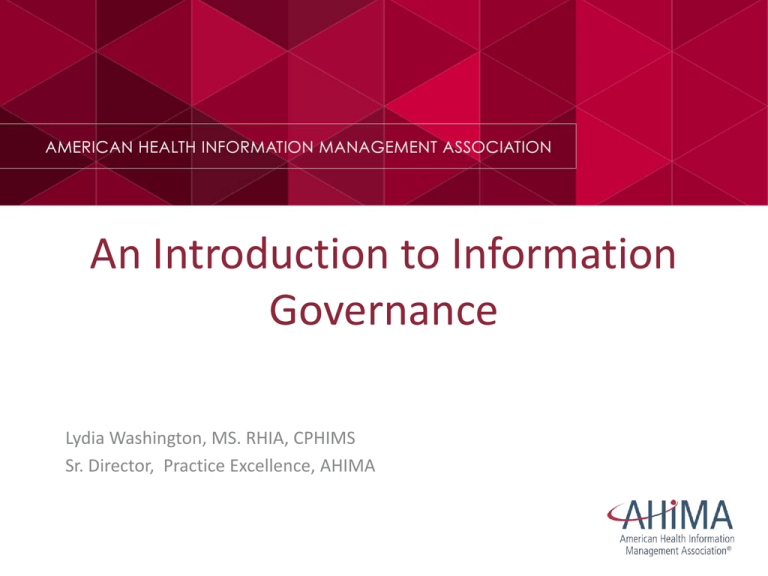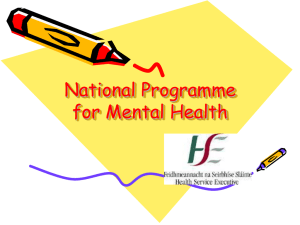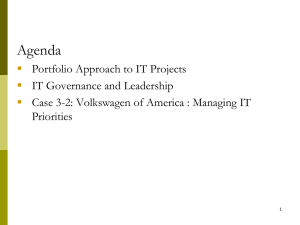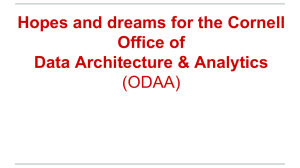An Introduction to Information Governance
advertisement

An Introduction to Information Governance Lydia Washington, MS. RHIA, CPHIMS Sr. Director, Practice Excellence, AHIMA Objectives • Define Information Governance, Data Governance, Enterprise Information Management & the relationship between them • Understand why Information Governance is important for healthcare organizations today • Discuss how to get started with developing an information governance program • Discuss personal preparation for leading an IG initiative What is Information Governance? • The specification of decision rights and an accountability framework to ensure appropriate behavior in the valuation, creation, storage, use, archiving and deletion of information • The processes, roles and policies, standards and metrics that ensure the effective and efficient use of information in enabling an organization to achieve its goals. (Source: Gartner) How does this differ from Data Governance? Data Governance is an important part of Information Governance, but not all of it. Information Governance addresses all types of unstructured & structured information that is collected or stored in the organization, whereas Data governance is focused only on structured data. What is Enterprise Information Management? All the things we do with and to information in order to 1) reduce risks ( examples: disaster recovery/business continuity; e-discovery/litigation response) 2) increase efficiencies (examples: enterprise content management; workflow management) 3) achieve competitive advantages (examples: business intelligence; predictive analytics; knowledge creation) Information Governance: Providing the Means for Enterprise IM The Goal: The Means: Information Governance Accountability mechanism Enterprise Information Management Structure and processes that ensure information is trustworthy and actionable Information Management vs. Enterprise Information Management Information Management (IM) Enterprise Information Management (EIM) • • • • Information management is siloed Not integrated across other business units Application-focused Focuses on a single department, process, business unit, or source of information • • • • Collaborative information sharing Integrated efforts across depts./business units Not application-focused Focus on single source of truth at enterprise level EIM Business Drivers Organizational memory and records • For patient care • For Compliance/Business/Legal needs Operational Efficiency • Patient safety and quality of care • Productivity • Competitive advantage Cost and Value • All information does not have the same value • Management of retention and storage is expensive • 30% to 50% of all information is redundant, outdated, or trivial Information Governance in Health Care Why Now? - Post EHR era - Information Management Crisis - Current environment requires data and information to be leveraged and optimized Post-EHR era • 4700 hospitals, 453,000 EP’s* have EHRs • HIM professionals – EHRs were “slammed in” • ~31% will soon adopt a second or third system • Poor data integrity, poor workflows, inadequate training • Attestations as of Feb 2014 Current Environment Demands Solid Data and Information • Emphasis on quality, safety, patient experience • Value based payment • ACO’s • Patient Centered Medical Home • Coordination of care • Population health management • Consumer and patient engagement Clinical and Business Intelligence in Healthcare • “Intelligence”= insight—not only what, but why and how • Information and analytics --the core --no longer just a byproduct • Information and data governance are foundational for Clinical and Business Intelligence • Essential for population health management • Analytics-transforms data into insight for improving care and reducing costs What Is the difference between Analytics and Analysis? Analysis Analytics • Deconstructing or • Applying scientific or breaking a complex quantitative methods to issue, part, topic or discern patterns and substance into provide insights smaller parts to gain a • Statistics, algorithms, better overall data mining and machine understanding learning • Examples: • Examples: – Who will need early re– Coding – Auditing – Workflow assessments – quality measurements admission? – Is fraudulent activity occurring? – What diseases am I at high risk for? Information Asset Management Lifecycle Management Risk Management and Mitigation Level of Service/Quality Current State Assessment Information Governance Long Term Planning The Bottom Line for Information Governance in Health Care There is an increasing need to ensure that information is trustworthy and actionable. Haven’t we always done IG? • Yes, we have some of the elements relative to some policies/processes/structures • No, IG is different in that it is: – Strategic – Enterprise focused, takes holistic approach – Addresses risk and compliance AND using information for business advantage Where Are We With IG in Healthcare? • 85% of health care delivery organizations have weak or no enterprise IG initiatives* • According to AHIMA case studies, initial efforts on EHR remediation • In some organizations, efforts are driven by internal counsel • Is 2015 the year of IG? What’s Under the IG Umbrella? General: • Data standards, integrity and quality • Privacy and security • Disaster preparedness and business continuity • Litigation response/ e-discovery • Lifecycle management/ preservation/ retention Health care specific: • Clinical documentation improvement?? • Clinical content management?? • Legal Health Record/Designated Records Set policy • Other? Initiating Information Governance • Establishing IG is at minimum a 12- to 18-month effort just to get started • Get an executive sponsor • Start with current state assessment Level of trust in information Existing Governance Infrastructure Assessment Business goals, strategy, drivers Cultural assessment Available resources (financial and other) What To Do First • Build a compelling business case – Start with your organization’s pain points, or look for a strategic business opportunity – Timing is critical • Acknowledge and get others to understand that this is not another another IT project – Collaborate with your CIO/IT—they may agree! • Develop a strategy – Identify goals, define purpose – Determine whose in charge/responsibility – Create high level work plan – Define measures of success How to get started: 1. Identify pain points 6. Identify and engage stakeholder group of 2. Make me money or committed individuals save me money? (look for those who are not happy 3. Collect and assess with or mistrust current state about data/info quality, availability, existing policies for gaps security, etc.) and deficiencies 7. Develop metrics to 4. Get and engage an assess progress and executive sponsor support evaluation 5. Plan your attack What to do after the initial push • Develop longer term IG Strategic Plan – Align with organization’s goals and strategy – Determine program scope • Identify required resources – Staff roles and responsibilities, budget, technology • Develop an IG framework – Core policies, standards, principles • Address enterprise communication and training needs Establishing a program--continued • Set up audit and enforcement mechanisms • Identify metrics, benchmarks and reporting mechanisms • Establish internal consulting role (contracts, IT purchases, compliance with plan, etc.) The 4 “R”s Information governance insures that accurate information gets to the right person, for the right reason, at the right time to make the right decisions. Preparing to Lead Information Governance • Natural fit and opportunity for growth for some HIM professionals • Where HIM is going/growing • Required skills/competency areas • soft skills associated with leadership, collaboration, and engagement, facilitation, critical thinking, problem-solving • Strategic vs. tactical outlook and perspective • change management and strategic communications • project management • information lifecycle management • business process improvement • understanding of healthcare regulatory compliance • information privacy and security • litigation and e-discovery • understanding of business intelligence and data analytics • information technology planning and governance • EHR/clinical decision support AHIMA: Leading Information Governance for Healthcare • • • • • Establishing an expert advisory panel Conducting surveys on IG in healthcare Publishing white papers on IG Develop principles for IG in healthcare Developing a maturity model and selfassessment tools • Developing, refining and providing resources to operationalize IG • Providing reference, webinars and forums to raise awareness of IG Additional Resources AHIMA Information Governance Page http://www.ahima.org/resources/infogov.aspx Questions/Discussion Lydia.Washington@ahima.org







